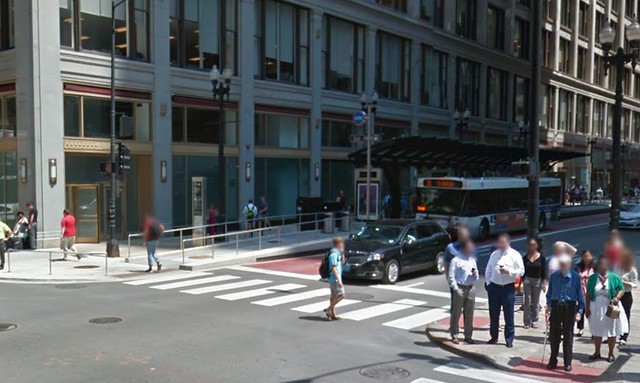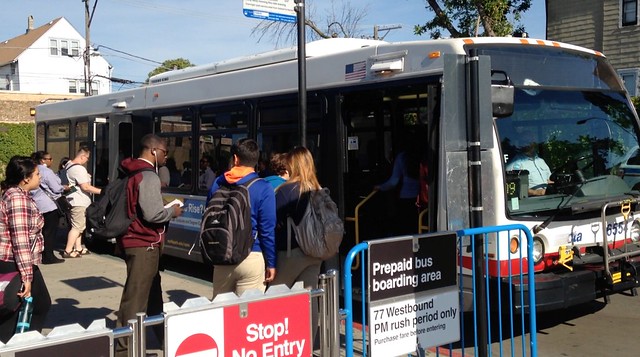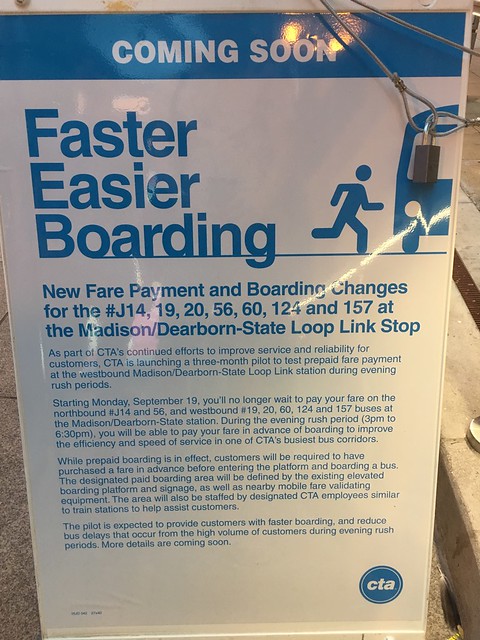
Since it launched last December, the Loop Link bus rapid transit system’s timesaving benefits have been modest, but they’re about to improve. The CTA just announced that this Monday, September 19, it's starting a three-month test of prepaid boarding -- in which customers pay their fare before the bus arrives -- at the BRT system's Madison/Dearborn station.
For several months after the December launch, the CTA required bus drivers to creep towards the raised stations at 3 mph in order to avoid striking waiting customers with side-view mirrors or crashing into the platforms. In recent months the transit agency lifted that overly cautious requirement.
Unauthorized vehicles in the red bus-only lanes – especially private shuttle buses – certainly aren’t helping Loop Link speeds. The #NotaCTABus social media campaign has raised awareness of the problem, so hopefully we’ll see some action from the city to address the issue in the near future.
But this latest announcement is the next step towards Loop Link reaching its full potential. Having passengers pay their fares before boarding the bus eliminates the delay caused by a line of riders having to swipe their Ventra card (perhaps multiple times) or put cash in the fare box while the bus waits.
Prepaid boarding is one of the key timesaving elements of BRT, and originally it was anticipated that Loop Link would launch with this feature at all eight stations. But in 2014, before construction on the corridor began, the city revealed that it planned to initially implement prepaid boarding only at Madison/Dearborn.
And in fall 2015, the city announced that prepaid boarding wouldn't even be in place at that station in time for the system's December debut. Instead, the CTA planned to pilot it at Madison/Dearborn sometime this summer. Monday is a couple of days before the fall equinox, so they’re the agency is just barely keeping its promise.
Meanwhile, in June the CTA launched a six-month test of prepaid boarding for westbound #77 Belmont Avenue buses departing from the Belmont station of the Blue Line’s O’Hare branch, only during evening rush hours. Riders pay their fares at a portable Ventra card reader, staffed by a customer assistant, and waiting in a fenced-off bullpen until the westbound bus shows up.
At that point, since everyone has paid the fare already, passengers can quickly board through both the front and rear bus doors. Customers I interviewed said they were pleased with the timesaving effect of the new style of boarding.
Some BRT systems in other cities, such as Mexico City, have turnstiles with fare card readers and enclosed platform stations where you wait until a bus shows up, similar to how payment on a subway works. New York’s Select bus routes feature kiosks where you buy a paper ticket while waiting for the bus, which you must present when the occasional onboard inspection occurs or else face a stiff fine.
Since the primitive, labor-intensive system at Belmont seems to be reasonably effective, the CTA is trying it at Madison/Dearborn from 3:00-6:30 p.m. on weekdays, for a three-month test period.
“By allowing CTA bus customers to pay fares in advance much like they do to ride the “L”, we will be able to determine how much more quickly customers are able to board buses and how bus service reliability is improved,” said CTA President Dorval Carter in a statement.

According to the transit agency, Madison/Dearborn is the busiest of the eight Loop Link stations, with over 2,300 boardings a day, and heavy ridership can lead to boarding times as long as four minutes during peak periods. This leads to longer trip times and the hated phenomenon of bus bunching – when customers wait an eternity for their ride only to have multiple buses show up at the same time.
During the period in which the pilot is in effect, customers traveling west on the #J14, #19 (used for special events only), #20, #56, #60, #124 and #157 routes will swipe their Ventra card or ticket, or personal credit or debit card, at a portable reader to enter a fenced-off waiting areas, as at Belmont Blue Line stop. As at Belmont, a CTA staffer will be on hand to assist customers and prevent fare evasion.
The CTA is encouraging customers at Madison/Dearborn who need to add transit value or unlimited ride passes to their Ventra account can easily add transit value or purchase 1-, 3-, 7- or 30-day unlimited ride passes at the Ventra machine inside the Walgreens directly behind the platform. Other options for adding value include ‘L’ stations and the Ventra app.
Hopefully the downtown prepaid boarding pilot will be a hit with customers and the CTA will deem it a success. Establishing prepaid boarding at all eight stations is going to be crucial for speeding up Loop Link buses to the extent that a critical mass of Chicagoans will feel it was worth it to swap mixed-traffic lanes for faster transit service. And that’s the only way the city will be able to garner enough political support to implement more robust BRT on streets like Ashland Avenue.





